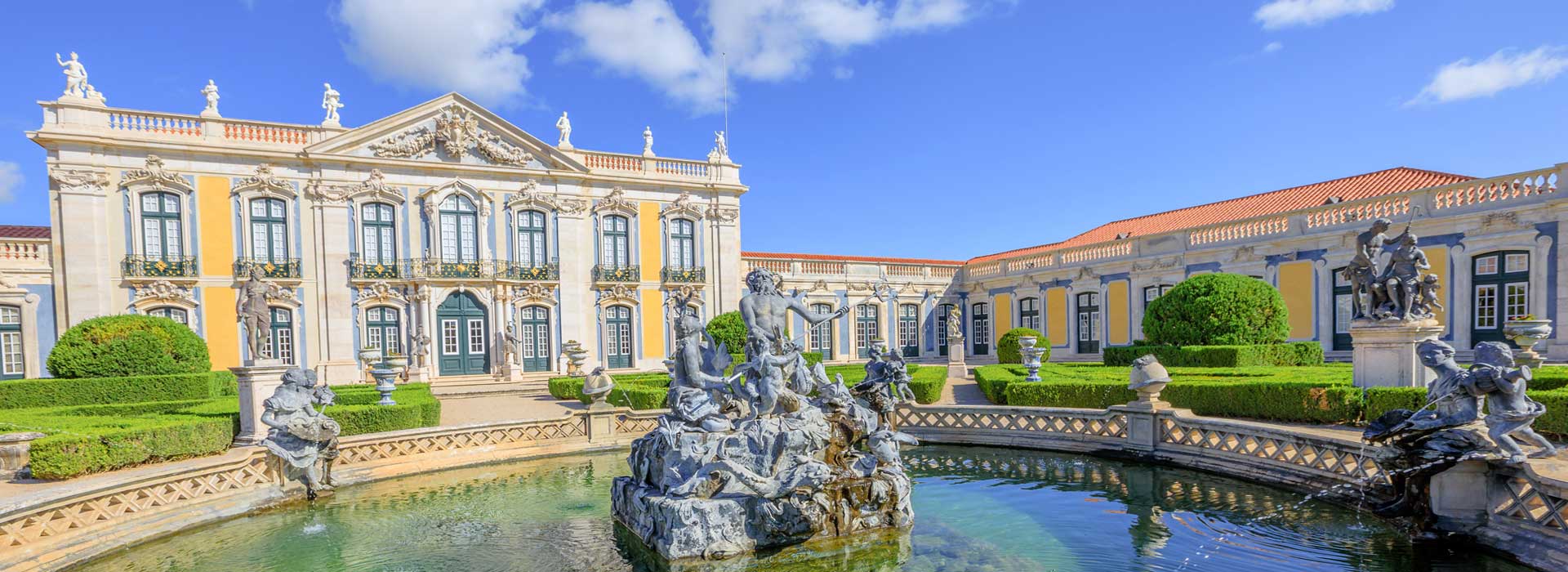
Located between Sintra and Lisbon, Queluz Palace stands as a remarkable testament to 18th-century grandeur. This architectural masterpiece seamlessly blends Baroque, Rococo, and Neoclassical styles, reflecting the evolving social landscape of its construction era. For travellers seeking an immersive experience, MADABOUTSINTRA.COM is your go-to travel guide. Discover essential information on how to reach Queluz and uncover its hidden treasures. Purchase your Skip-the-Line e-ticket here to streamline your visit, saving both time and money.
Step into a world of opulence as you explore the palace's lavish interiors and wander through its impressive gardens. With convenient access from Lisbon or Sintra, Queluz Palace offers an unforgettable day trip filled with history, culture, and architectural splendour. Whether marvelling at the intricate details of its design or soaking in the beauty of its landscaped grounds, Queluz Palace promises a memorable journey into Portugal's rich heritage.

With this entrance ticket, you can gain entry to Queluz Palacee at your leisure. Buy online before you arrive to avoid queues and have the convenience of the e-ticket on your phone. Book with confidence with the FREE CANCELLATION option.
Book with confidence with the FREE CANCELLATION option.
• Kids under Five get in free, no ticket required
• If your plans change we have you covered with the option to cancel and get a full refund
Low Season, Daily: 09h00 - 18h00, (last admission 17h00)
High Season Daily: 09h00 - 19h00, (last admission 18h00)
Adult: €13.00, Consessionary tickets available on-site.
![]() Lisbon Card: 15% discount
Lisbon Card: 15% discount
Contact Details
Largo Palácio de Queluz, 2745-191 Queluz, Portugal. |
38° 46' 19.2" N | 09° 17' 31.2" W | +351 219 237 300
info@parquesdesintra.pt | Website

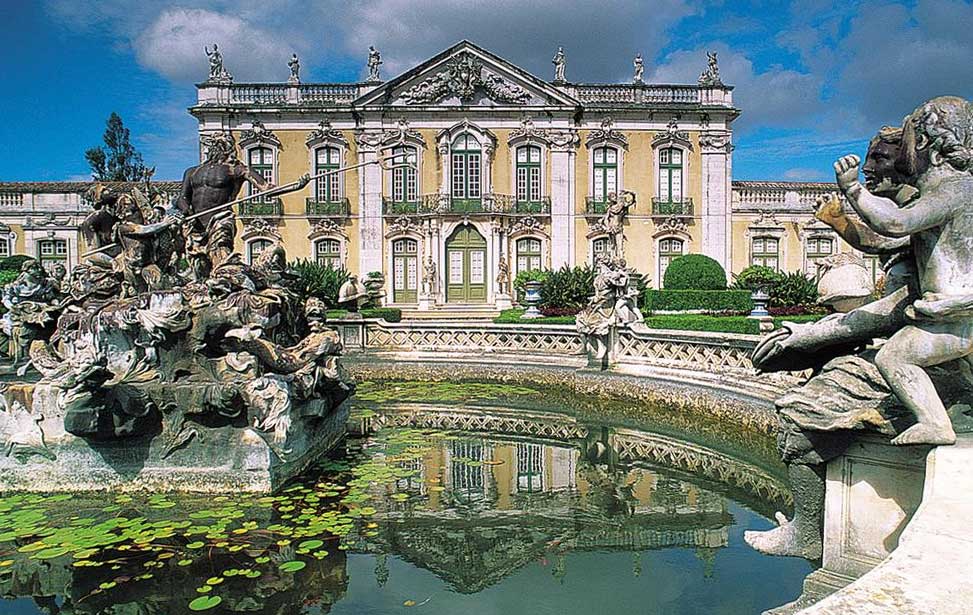
National Palace of Queluz façade
Between 1742 and 1758, Mateus Vicente de Oliveira, renowned for his work on the Palace at Mafra, undertook the transformation of a country house into a majestic palace. However, it was the announcement of Prince Pedro's marriage to Princess Maria in 1760 that spurred a new phase of construction. Jean-Baptiste Robillion, an esteemed architect and goldsmith, was tasked with enhancing the palace's grandness to befit royalty. Under Robillion's direction, the throne room and private chambers pavilion were added, elevating Queluz's status as a regal residence.
In 1784, Manuel Caetano de Sousa assumed control of the construction, implementing further modifications to the second floor and private apartments. Following a fire at the Royal Complex of Ajuda in 1794, Queluz assumed the role of the official royal residence for Queen Maria I and Prince Regent João VI. Additional upgrades were made to accommodate the household guards and court.
Despite its grandeur, Queluz Palace became a gilded cage for Queen Maria, who struggled with bouts of mania and depression following the death of her husband and oldest son. The Portuguese royal family resided at Queluz until their departure to Brazil in 1807, fleeing Napoleon's advancing troops.
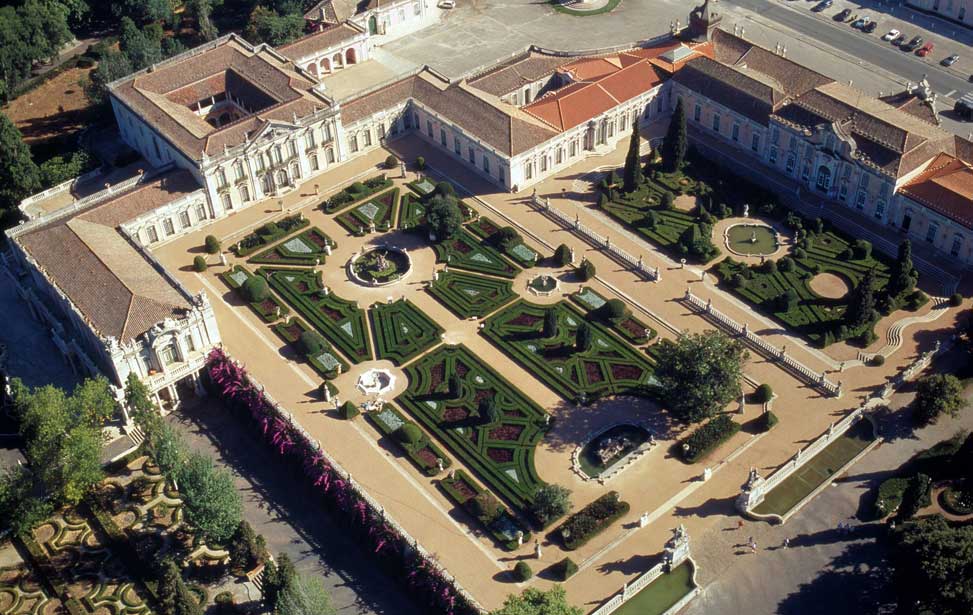
National Palace of Queluz - aerial view
Following the departure of King João VI and the Portuguese Court to Brazil in 1821, the Palace entered a period of decline. Upon their return, Queen Carlota Joaquina resumed residence at Queluz, albeit in semi-exile. During the tumultuous wars between siblings, King Miguel (1802-1866) sought refuge in Queluz Palace. Tragically, Miguel succumbed to tuberculosis in the same room where he was born, just 36 years earlier, following the liberal victory.
In 1957, the Queen Maria Pavilion in the East wing became the official residence for foreign Heads of State during their visits. Over the years, Queluz Palace has served various purposes, including housing a zoo in the early 19th century. Today, the Royal Guard building across the courtyard has been converted into a Pousada.
Designated as a National Monument in 1910, Queluz Palace joined the Network of European Royal Residences in 2013, further solidifying its historical significance and cultural importance.

On this tour, you will have the opportunity to visit the Queluz National Palace, the Moorish Castle and the Mafra National Palace, a Basilica and a Convent. You will get to know the splendid village of Ericeira, one of the few places in the world that have been declared a World Surfing Reserve. You will be dazzled by the José Franco Typical Village and its miniature museum. It demonstrates the various daily activities of the early twentieth century.
(1) | 8 Hr | ✔ Free Cancellation
Check Availability
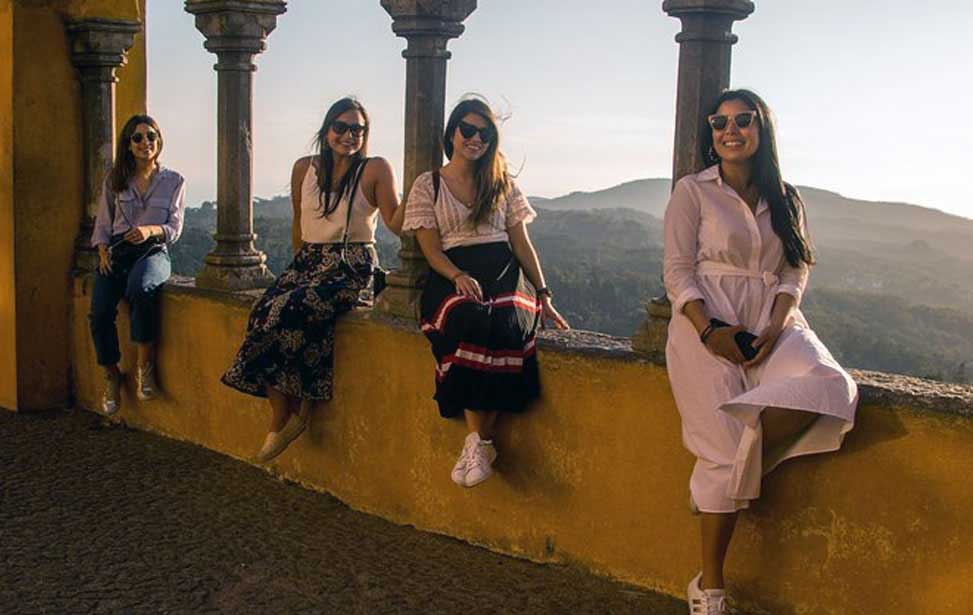
The tour will be a day trip where travellers can enjoy the different faces of Sintra. From the historic centre and the marvellous monuments to the coastline, where small villages are nestled between the rocks and the sea. The itinerary is designed in a way guests can visit the most popular spots. Discover the hidden treasures only the locals know of and taste the fantastic Portuguese cuisine. We will avoid crowds and your tour is 100% customisable.
(683) | 8 Hr | ✔ Free Cancellation
Check Availability
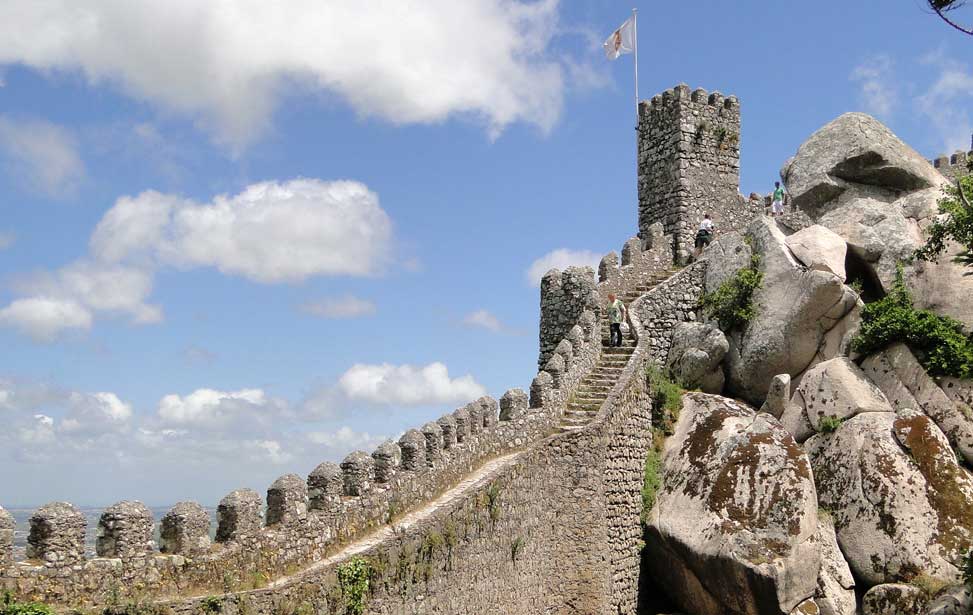
Through the eyes of a former journalist, in love with Portugal and Portuguese culture and history. Come to Sintra to see palaces and monuments that make the history of Portugal in the 18th and 19th centuries. You don't have to wait in line to buy a ticket and go ahead without wasting time. Stop for lunch at a typical Portuguese restaurant on the seafront or in the picturesque village centre. Get to know the coast of Sintra and the westernmost point of Continental Europe; Cabo da Roca. A day well spent taken at your own pace. This tour is a unique and personalised experience.
(6) | 8 Hr | ✔ Free Cancellation
Check Availability
The unassuming exterior of the palace belies its opulent interior. The Throne Room, affectionately known as the Big House, stands as the most lavish of the three staterooms within the Palace of Queluz, designed to awe visitors. Crafted in the regency-rococo style, its walls are adorned with intricate carvings by sculptor Silvestre de Faria Lobo, while the figurative paintings on the ceiling, painted by João de Freitas Leitão, add to its grandeur. Enormous chandeliers hang from the centre of the ceilings, a testament to its grand past when it hosted lavish balls and concerts during Pedro and Maria's reign. Today, the Throne Room continues its legacy by serving as the venue for state banquets and other important state events hosted by the President of the Republic.
Equally sumptuous is the Ambassador Room, featuring stunning painted ceilings by Bruno José do Vale and Francisco de Melo. The central panel depicts the royal family in a serenade, replicating the original canvas by Italian painter Giovanni Berardi, which was tragically destroyed in a fire in 1934. The room's chequered marble floor, once graced by dignitaries paying homage to the Prince Regent, now stands as a reminder of its regal past. Ornate mirrors adorning the walls reflect the shimmer of gold gilding, adding to the room's magnificence.
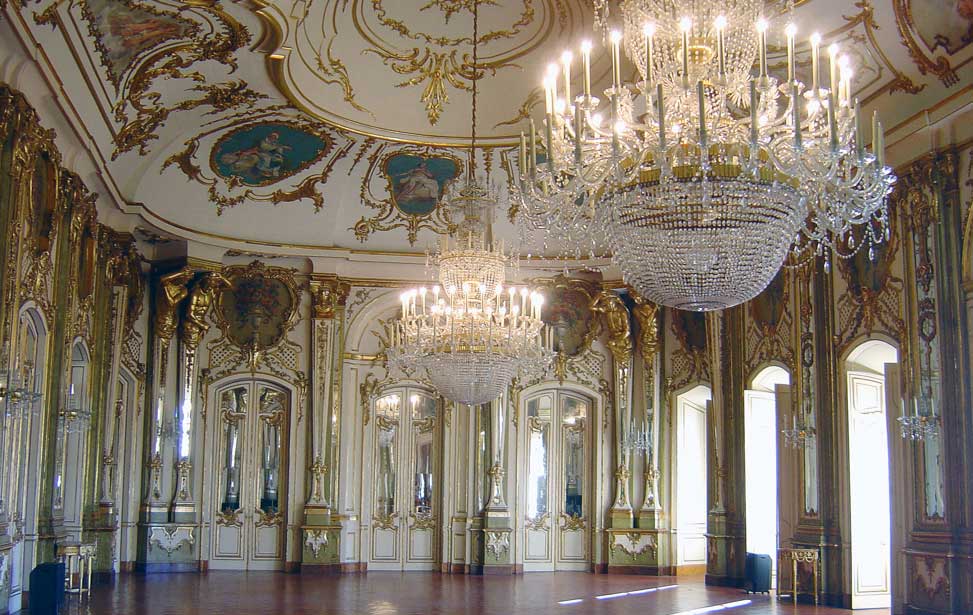
The Throne Room
The palace kitchens have been well maintained and now houses the Cozinha Velha restaurant, owned by the Pousada. The restaurant features a large stone fireplace as its centerpiece and the tables are arranged under a beautiful wooden ceiling. Authentic copper cooking utensils hang from the walls. Dining at this restaurant is a great way to experience history, and the desserts are made using original convent recipes. | Daily: 12h30 - 15h00pm/19h30 - 22h00
Restaurant Contact Details
Largo do Palácio Nacional, 2745-191, Queluz, Portugal.
38° 46' 19.2" N | 09° 17' 31.2" W | +351 214 356 158
guest@pousadas.pt | Website

Cozinha Velha restaurant
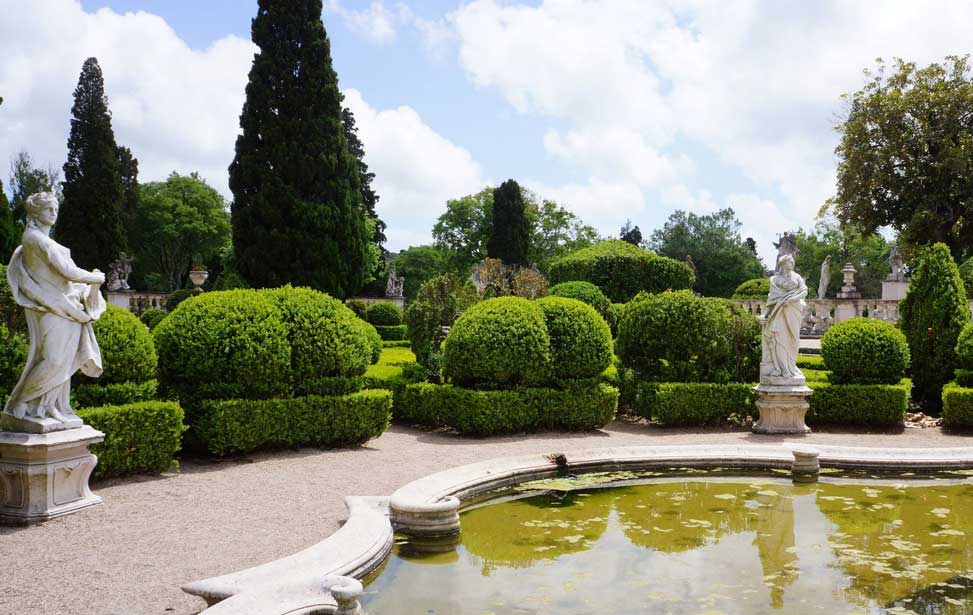
National Palace of Queluz Gardens
Often hailed as the "Versailles of Portugal," the gardens of Queluz are a testament to exuberance. Dotted throughout are statues depicting characters from classical mythology, standing amidst various parterre gardens like the Hanging Garden and the Malta Garden, each showcasing unique designs. A network of pathways, including a series of avenues radiating from the main building, forms an intricate geometrical grid connecting lakes and water features.
The centrepiece of the gardens is the majestic Medallions Lake, conceived by French architect Jean-Baptiste Robillion in 1764, boasting a star-like octagonal shape. Another notable feature is the "Portico dos Cavalinhos," a garden temple flanked by equestrian statues and sphinxes adorned in 18th-century attire.
Besides French influences, the gardens also reflect Flemish design with the inclusion of canals, the largest of which lies near the Lion's Staircase. Stretching over 100 metres, these canals feature walls adorned with tiled panels depicting maritime scenes, reminiscent of the grand festivals held during the 18th century, where fully rigged ships sailed in procession.
Established in 1979, the Portuguese School of Equestrian Art traces its roots back to the Real Picaria, the esteemed equestrian academy of the Portuguese Court founded in the 18th century at Queluz. Dedicated to upholding the heritage of traditional Portuguese equestrian art, the school is renowned for its commitment to preserving, teaching, and promoting this rich cultural tradition.
At the heart of the school's activities is the training and showcasing of the famed Lusitano breed, nurtured at the Alter Real Stud Farm and expertly trained on-site. Visitors have the unique opportunity to witness captivating performances and training sessions at the Henrique Calado Riding Ring in Belém, Lisbon, where the school opens its doors to the general public. Whether you're a seasoned equestrian enthusiast or simply intrigued by the artistry of horsemanship, experiencing the elegance and grace of these magnificent creatures is an unforgettable experience.
Presentations Tuesdays - Saturdays (except the last Saturday of each month): 10h00 - 13h00
Gala Last Friday of each month (with some exceptions)
Contact Details
Henrique Calado Riding Ring, Calçada da Ajuda, 1300-006, Belém, Lisbon, Portugal.
38° 42' 01.5"N | 09° 11' 59.8"W | +351 219 237 300
info@parquesdesintra.pt | Website
Situated in the building formerly used by the Royal Guard of the Court at the Palace of Queluz, this luxury hotel offers spacious rooms with satellite TV. The air-conditioned rooms at Pousada Palacio de Queluz are individually decorated and feature warm colours and elegant wooden furniture. All rooms have a work desk, a minibar, and an en suite bathroom with a hairdryer. Guests can enjoy authentic Portuguese dishes as well as international cuisine in Pousada Palacio de Queluz‘s restaurant, Cozinha Velha. The bar serves a selection of refreshing drinks and snacks. Room service is available.
Contact Details
Largo Palácio Nacional de Queluz, 2745-191 Queluz, Portugal. |
38° 45' 03.1" N | 09° 15' 27.1" W
Check Availability


Queluz Palace is located half way between Lisbon and Sintra, about ten miles (16km) and is easy accessible by public transport from both places.
|
From Lisbon or Sintra take the IC19 and exit at 'Queluz – Palácio' and keep on following the signs. | |
Urban train services (comboios urbanos) from Lisbon's central train station Rossio and Sintra are regular and reliable. If coming from Lisbon alight at Queluz-Belas and if you are coming from Sintra, get off at Monte Abraão. There's a 15-20 minute walk to the Palace from both stations. |
|
|
Vimeca run services between Lisbon and Queluz:
|
Contact Details
Largo Palácio de Queluz, 2745-191 Queluz, Portugal.
38° 46' 19.2" N | 09° 17' 31.2" W | +351 219 237 300
info@parquesdesintra.pt | Website